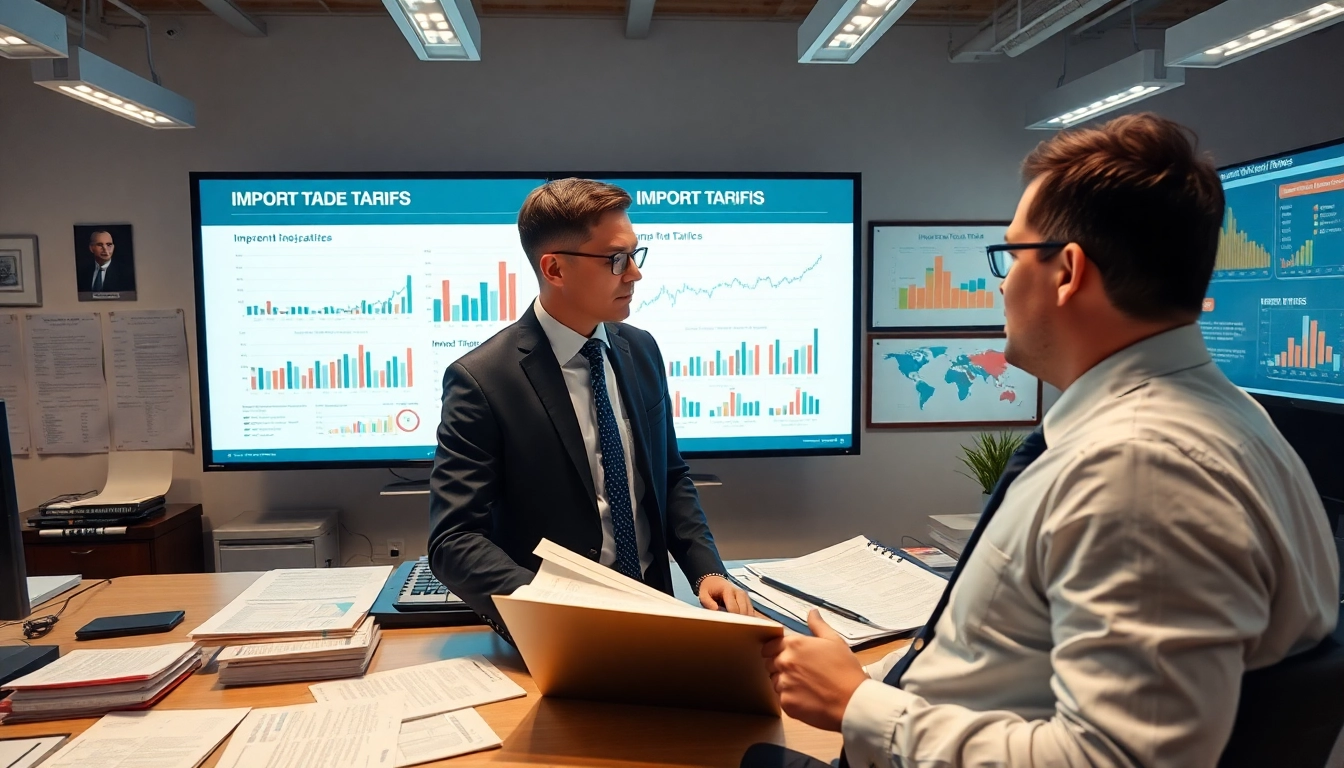Understanding Import Tariffs and Their Implications
What Are Import Tariffs?
Import tariffs are taxes imposed by a government on goods and services imported from foreign countries. They are generally calculated as a percentage of the total value of the goods being imported. The main purpose of these tariffs is to make foreign products more expensive, thereby encouraging consumers to purchase domestically produced goods. This effect not only protects local industries but also has broader implications for international trade relationships, taxation revenues, and consumer prices.
How Import Tariffs Affect International Trade
Import tariffs influence international trade dynamics in numerous ways. By increasing the cost of imported goods, they can lead to a decrease in import volumes. In contrast, domestic producers may benefit from reduced foreign competition, which can enhance local production and employment rates. However, high tariffs can also lead to trade retaliation by countries affected by these policies, resulting in trade wars and market instability. This complex dance of tariffs and trade agreements can make international markets volatile, affecting not only businesses but consumers as well.
The Role of Tariffs in U.S.-China Trade Relations
The U.S.-China trade relationship has been deeply affected by tariffs. Tensions between the two nations escalated in the past few years, culminating in a series of tariff increases and negotiations. The imposition of tariffs on Chinese goods was initially aimed at addressing trade imbalances and protecting American industries from unfair competition. For example, as recently as two days ago, reports surfaced that President Trump had stated the U.S. would impose a 55% tariff on various Chinese imports as part of a new trade framework, significantly impacting supply chains and global market dynamics. Import tariffs china continue to be a critical topic in discussions surrounding international trade, as various factors influence the tariffs imposed and the responses from China.
Current Import Tariff Rates on Chinese Goods
Overview of Current Tariff Structures
As of now, the effective tariff rate on most Chinese imports stands at approximately 30%, having been reduced from a peak of more than 145%. The intricacies of tariff structures vary greatly depending on the type of goods being imported. Some categories, such as electronics and machinery, face higher rates due to their significance in both countries’ economies, while agricultural products may be treated differently. The introduction of these tariffs is often complicated by existing agreements and trade standards that fluctuate based on diplomatic relations.
Recent Changes in Tariff Policies
Tariff policies have seen significant alterations over the past years, particularly during Trump’s presidency, where a shift from the agreement-based tariff rates to direct percentage tariffs was implemented. Recently, in May 2025, the U.S. and China reached an agreement to lower reciprocal tariff rates to 10 percent from higher peaks which were seen as detrimental to trade. Nevertheless, the recent announcement of a 55% tariff signifies a potential re-escalation in these tariff rates, igniting fears of increased costs across various sectors reliant on Chinese imports.
Comparative Analysis: U.S. vs Other Nations
The U.S. has one of the highest tariff rates on imports from China compared to other nations. For example, countries within the European Union often leverage lower tariffs on Chinese goods due to broader trade agreements. This discrepancy places U.S. businesses at a competitive disadvantage in certain markets, leading to calls for more strategic trade policies. An analysis of tariff rates globally indicates that while the U.S. imposes strict tariffs, nations like Canada and those in the EU demonstrate more moderate approaches, prompting discussions on equitable trade practices.
Factors Influencing Tariff Rates on China
Political Climate Impacting Tariff Decisions
The political climate plays a crucial role in shaping tariff rates. Political agendas, elections, and party ideologies can influence tariff policies significantly. For instance, shifts in leadership can lead to drastic changes in international trade policies. Tariffs on Chinese goods have been a contentious issue, influenced heavily by nationalist agendas and economic protectionism. The current administration’s stance on China has led to policies that curtail imports, suggesting a continuing trend of protectionist tariffs, which could remain in place should current political dynamics persist.
Economic Factors Affecting Trade Relations
The economic landscape, both domestically and globally, impacts tariff rates significantly. Factors such as inflation, currency fluctuations, and economic growth rates contribute to decisions made regarding import tariffs. For instance, as the U.S. economy grows, there may be a tendency to impose higher tariffs to protect local industries from foreign competition. Conversely, if economic growth stagnates or recesses, governments may reassess their tariffs to stimulate trade and economic activity. The relationship between economic conditions and tariff structures remains a fluid one and is currently observed in the fluctuating tariffs on Chinese imports.
Global Trade Agreements and Tariff Rates
Global trade agreements significantly influence tariff rates, often leading to reduced tariffs among member countries. Agreements like the World Trade Organization (WTO) frameworks aim to create a fair trading environment where tariffs are minimized. The U.S. and China, through various trade deals and negotiations, have witnessed changes in tariff policies reflecting broader geopolitical landscapes. The ongoing adjustments to tariffs highlight the interdependent nature of international relations and trade agreements, wherein changes in one country can reverberate across borders and impact global markets.
Strategies for Businesses Navigating Tariff Changes
Assessing the Impact on Supply Chains
With ongoing tariff changes, businesses must evaluate how these adjustments impact their supply chains. Companies heavily reliant on Chinese imports must consider diversifying their suppliers to mitigate risks associated with high tariffs. This could involve sourcing materials from other countries or investing in local production capacities. Furthermore, businesses should assess manufacturing processes within the context of tariff implications, ensuring that they remain competitive while adhering to compliance requirements.
Adapting Pricing Strategies to Tariff Increases
As import tariffs increase, businesses must renegotiate pricing strategies to absorb potential costs without losing market competitiveness. This can involve adjusting product prices based on market elasticities, exploring cost-reduction strategies, and leveraging marketing tactics to maintain consumer interest. By maintaining transparency regarding price changes and explaining the rationale behind them, businesses can also safeguard their consumer relations and uphold brand loyalty even in turbulent economic times.
Long-term Planning for Trade Relations
Long-term planning for trade relations is essential for businesses engaged in international markets. Companies must stay informed about geopolitical trends, potential tariff adjustments, and emerging trade agreements. This could involve forming strategic alliances with different suppliers or investment in technologies that enhance productivity and reduce dependency on foreign inputs. Long-term strategies should also encompass risk management frameworks that account for the unpredictability of international trade relations.
Looking Ahead: Future of Import Tariffs on China
Expert Predictions on Tariff Changes
Looking forward, predictions about tariff changes on Chinese goods remain a mix of uncertainty and cautious optimism. Economists suggest that based on the political climate and ongoing negotiations, tariffs may either stabilize in response to potential new trade agreements or continue their fluctuating state depending on economic performance. Experts are divided on where these tariffs will settle, with some expecting long-term tariffs to remain elevated while others believe in the possibility of future reductions.
Potential Economic Impacts of Adjusted Tariff Rates
Any adjustments to tariff rates will have significant ripple effects across various economic sectors. A potential decrease in tariffs could lead to lowered consumer prices for goods reliant on Chinese imports, thus stimulating consumer spending and economic growth. On the other hand, prolonged high tariffs could incite inflation and challenge economic resilience, especially for sectors that rely heavily on affordable imports for their operation. A thorough analysis of these economic impacts is necessary for formulating effective trade policies.
Preparing for Future Trade Agreements
Businesses must prepare for future trade agreements by actively participating in negotiations, staying informed about international trade policies, and engaging with industry associations that represent their interests. Understanding the intricacies of trade agreements can equip companies with the tools necessary to navigate tariff landscapes effectively while exploring opportunities for growth and expansion in foreign markets.








